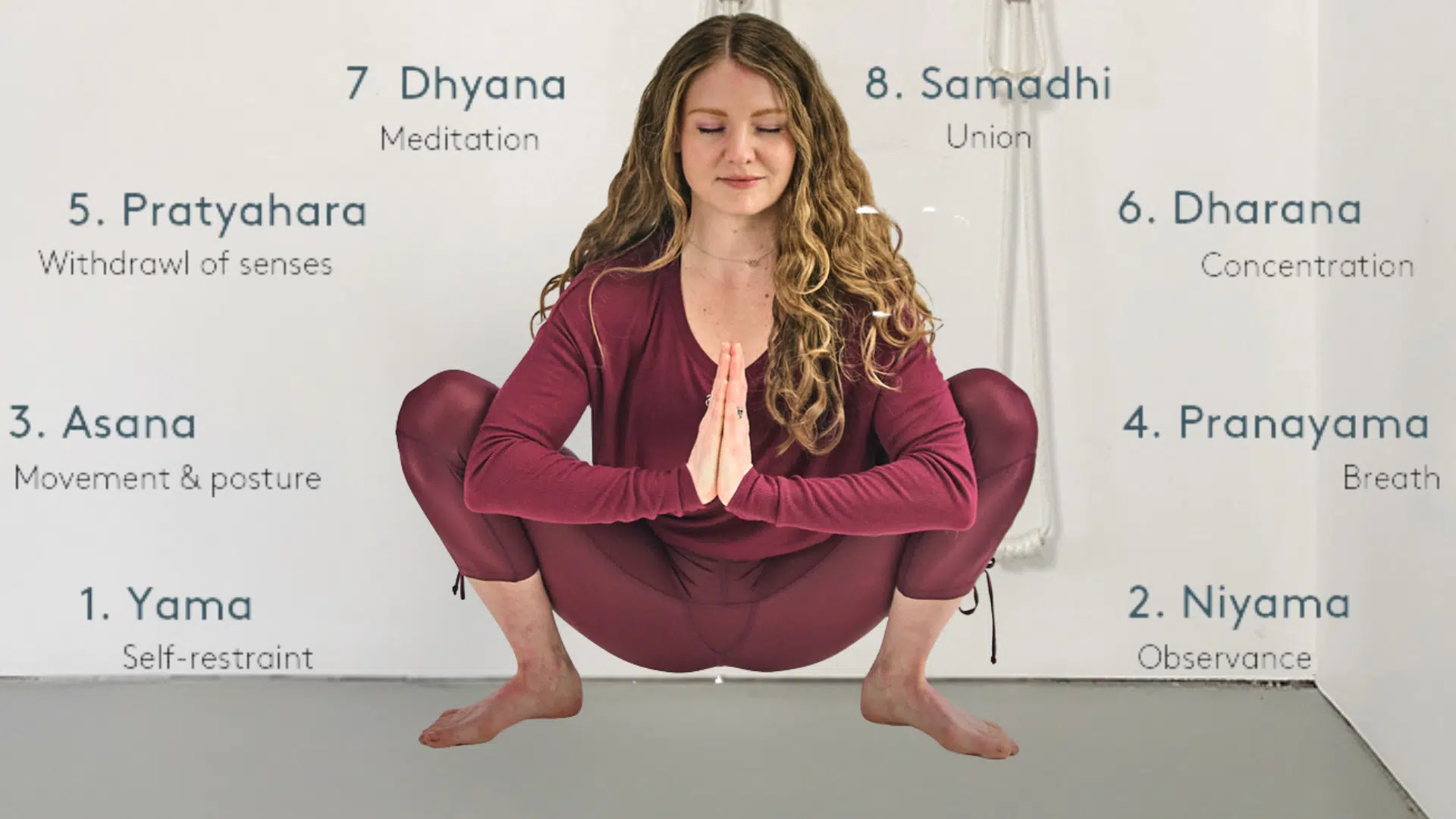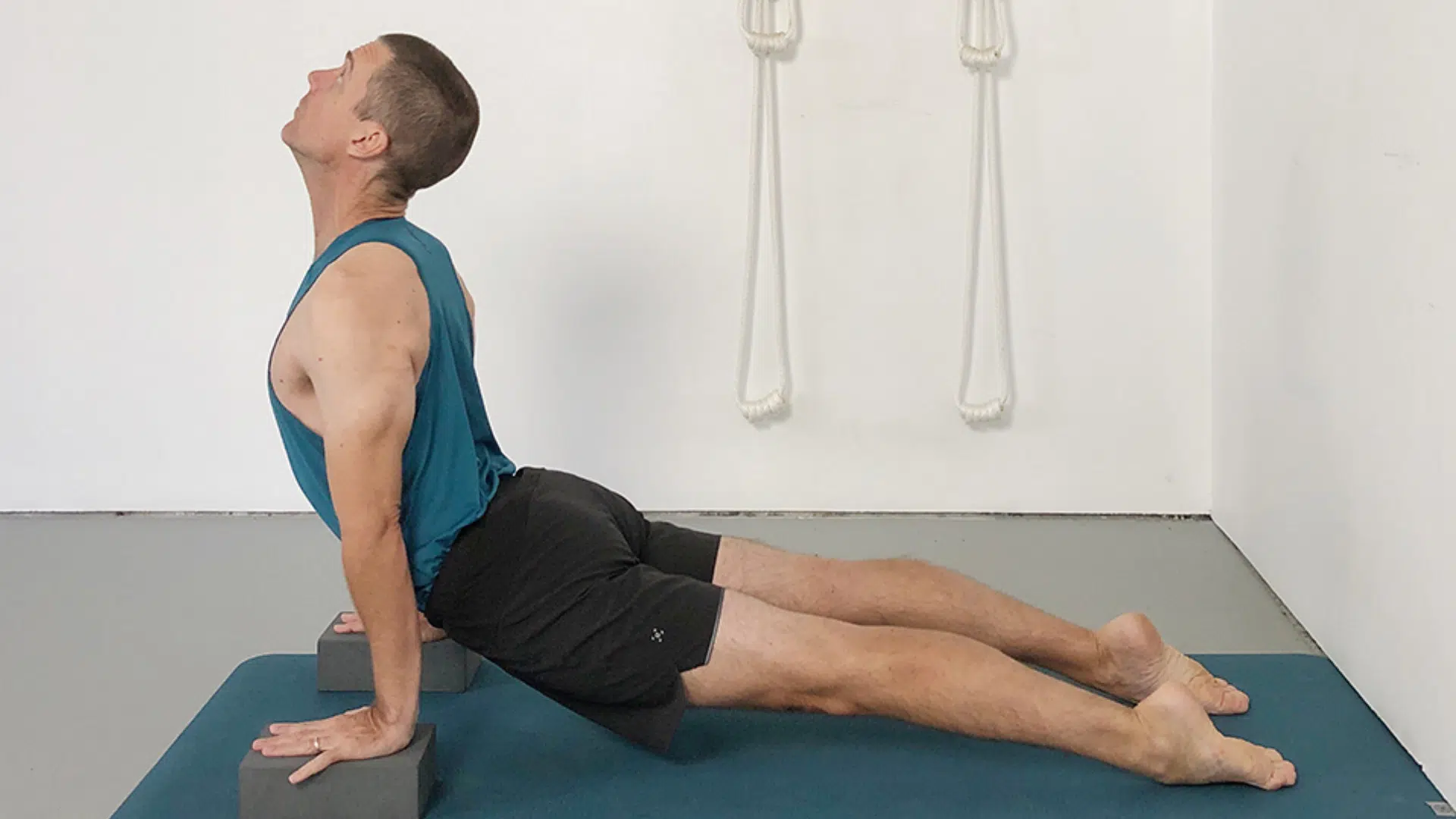Yoga is more than just movement; it’s a disciplined practice rooted in ancient wisdom.
Learning the Sanskrit terms that define Yoga as a discipline can help you better understand the purpose behind each pose, breath, and mindset.
In this blog, I’ll guide you through standard Sanskrit terms, from core concepts like Tapas (discipline) to paths like Raja Yoga and Bhakti Yoga, revealing how each one shapes your yoga path.
Ready to start deepening your practice? Let’s dig in.
What Does ‘Discipline’ Mean in the Yogic Context?
In yoga, discipline goes beyond rigid rules; it’s about cultivating inner strength and consistency.
The Sanskrit word Tapas [Tuh-pahs] represents the self-discipline and spiritual fire needed to push through challenges and grow.
Similarly, Sadhana [Sah-dah-nuh] refers to a daily spiritual practice that aligns your actions with intention and devotion.
Together, these principles guide practitioners on the path to self-realization, helping them overcome obstacles and stay focused on their way towards balance and inner peace.
Yoga Discipline Sanskrit: The Root Meaning
The word Yoga [Yoh-guh] comes from the Sanskrit root “yuj”, meaning “to yoke” or “to unite.” It represents the union of body, mind, and spirit, emphasizing harmony and balance.
Yoga is more than just physical exercise; it’s a structured lifestyle system that encourages mindfulness, discipline, and inner peace.
By aligning all aspects of the self, yoga helps practitioners achieve greater self-awareness and connect with their true essence, leading to a more fulfilling life.
The Classical Yoga Disciplines in Sanskrit


Each yoga discipline offers a unique path to personal change, leading practitioners toward the union of body, mind, and spirit.
1. Hatha Yoga: [Hah-thah Yoh-gah]
Hatha Yoga combines “Ha” (sun) and “Tha” (moon), symbolizing balance between opposing energies. This discipline focuses on asana (postures), pranayama (breathing exercises), and cleansing practices to prepare the body for meditation.
Hatha is often considered a gateway for beginners, helping them develop strength, flexibility, and mental clarity through a steady, disciplined practice.
Its gentle pace makes it accessible to those new to yoga, while still offering significant benefits for seasoned practitioners seeking balance and alignment.
2. Raja Yoga: [Rah-jah Yoh-gah]
Known as the “royal path,” Raja Yoga is based on Patanjali’s Eight Limbs of Yoga, which provide a structured approach to mastering the mind. This discipline emphasizes meditation and samadhi (liberation or absorption), aiming for mental mastery and self-realization.
Through ethical conduct, concentration, and mindfulness, practitioners move toward a deeper awareness of the self.
Raja Yoga is often seen as the highest form of yoga, focusing on mastering inner stillness and achieving spiritual liberation through disciplined practice and meditation.
3. Jnana Yoga: [Jnah-nah Yoh-gah]
Jnana Yoga is the path of wisdom and self-inquiry. It encourages deep introspection and the pursuit of knowledge through philosophical study, contemplation, and meditation.
The central question is: Who am I? Practitioners engage in self-reflection to transcend the ego and understand their true nature. Jnana Yoga is often paired with Vedantic texts, which explore the nature of reality and consciousness.
This intellectual path is best suited for those who are drawn to deep, philosophical inquiry and seeking to understand the nature of existence.
4. Bhakti Yoga: [Bhahk-tee Yoh-gah]
Bhakti Yoga is the path of love and devotion. It focuses on developing an emotional connection to the Divine through practices like chanting, prayer, and rituals. This discipline nurtures humility, compassion, and surrender.
It’s about surrendering the ego and offering your love and service to a higher power, often expressed through personal devotion.
Bhakti Yoga is heart-centered, helping practitioners cultivate emotional balance and spiritual connection, making it a perfect practice for those who find spirituality through love, emotion, and devotion to a higher consciousness.
5. Karma Yoga: [Kar-mah Yoh-gah]
Karma Yoga is the yoga of selfless action and service. It teaches practitioners to act without attachment to the results, focusing on duty and responsibility without expecting personal gain.
Inspired by teachings from the Bhagavad Gita, Karma Yoga emphasizes acting for the welfare of others and living with a sense of purpose.
This path is ideal for those who are engaged in daily activities, such as work or community service, and seek to transform ordinary actions into spiritual practice by offering them to the greater good, free from ego.
6. Mantra Yoga: [Man-trah Yoh-gah]
Mantra Yoga involves the use of sacred sounds or mantras to achieve union through vibration and consciousness.
The practice includes Japa (repetition) of mantras or Bija (seed) sounds like Om, which are believed to carry profound spiritual energy. Repeating mantras helps focus the mind, calm mental chatter, and deepen concentration.
Through the repetition of specific sounds, Mantra Yoga shifts consciousness, promoting mental clarity and spiritual growth.
This path is effective for practitioners seeking to improve their ability to concentrate, meditate, and tap into a higher level of awareness.
Detailed Practical Sanskrit Usage in Daily Yoga
Incorporating Sanskrit terms into your daily practice improves connection, mindfulness, and deepens your yoga experience through language rooted in tradition.
How to Integrate Sanskrit Terms into Your Practice
To integrate Sanskrit terms into your daily yoga practice, start by associating each pose with its Sanskrit name, such as Adho Mukha Svanasana (downward dog).
Saying the names aloud during your practice can help reinforce memory and connection.
If you’re a teacher, encourage students to use terms like Tadasana, or Mountain Pose, to honor tradition and deepen their experience. Use simple repetition to gradually familiarize them.
Sanskrit Pronunciation Tips
Accurate pronunciation of Sanskrit terms is key to ensuring the practice retains its spiritual and meditative energy.
Begin with simple terms like Tadasana (Mountain Pose) and Bhujangasana (Cobra Pose), practicing the correct sounds.
Pronunciation aligns with the vibrational energy of each term, enhancing its impact on your practice. Using audio guides or recorded examples will help you master the sounds more effectively.
Deeper Study of Sanskrit Words and Their Etymology
Find the symbolic meanings and spiritual significance behind key Sanskrit terms, and understand how they shape the yoga.
Tapas (self-discipline)
Tapas refers to the inner fire needed to push through obstacles and resistance. In yoga, it’s about embracing discomfort and overcoming hesitation.
Tapas is essential for personal change, requiring sustained effort even when faced with challenges. It helps break through laziness and builds resilience, making it a vital force in a yogic lifestyle.
Tapas teaches the power of consistent practice to change the mind and body, fostering growth and spiritual awakening.
Sadhana (spiritual practice):
Sadhana is a daily spiritual practice that deepens one’s connection with the self and the Divine. It represents the act of engaging in consistent efforts, even through meditation, asana, or pranayama, to achieve personal growth and spiritual evolution.
Sadhana fosters discipline and focus, making it the cornerstone of a yogic lifestyle. By committing to a daily practice, practitioners create space for inner change, mindfulness, and connection with their true essence, leading to a more balanced life.
Pranayama
Pranayama, meaning the control of breath, explores the deep connection between breath and the life force or prana. In Sanskrit, prana means “life force,” and yama means “control” or “discipline.”
This practice goes beyond simply breathing; it taps into the energy that sustains life. Pranayama helps clear mental fog, reduce stress, and deepen focus, improving both physical and mental clarity.
By regulating the breath, practitioners can improve their emotional and spiritual well-being, allowing energy to flow freely throughout the body.
Asana
Originally, Asana meant “seat” in Sanskrit, reflecting the early yogic practice of sitting for meditation. Over time, as yoga evolved, asanas came to represent physical postures that prepare the body for spiritual practice.
Each posture helps the body release tension, improve flexibility, and improve strength, allowing for a more comfortable meditation posture.
The shift from “seat” to “posture” reflects yoga’s emphasis on balance and equilibrium in the body, mind, and spirit, with each asana serving as a stepping stone toward mental calm and self-awareness.
The Cultural Context of Sanskrit in Yoga Practice
Understand the vital role of Sanskrit in preserving the authenticity and spiritual depth of yoga, connecting ancient wisdom to modern practice.
Sanskrit’s Role in Preserving Yoga’s Authenticity
Sanskrit is the foundation of yoga’s spiritual heritage, deeply embedded in ancient texts like the Yoga Sutras and the Bhagavad Gita.
Correct pronunciation of Sanskrit terms retains their meditative and spiritual energy, enhancing the power of yoga practice.
Modern practitioners, especially in the West, continue to use Sanskrit terms to maintain a connection to yoga’s roots, ensuring the tradition is respected and its full potential is realized in practice.
Sanskrit Across Different Yoga Lineages
Yoga lineages such as Iyengar, Vinyasa, and Ashtanga integrate Sanskrit in unique ways to emphasize their distinct approaches.
For example, Iyengar focuses on precise alignment, often using Sanskrit to describe specific body actions.
Vinyasa connects Sanskrit terminology with flowing movements, while Ashtanga emphasizes sequence consistency.
The use of Sanskrit influences teaching styles, providing a shared vocabulary that creates a deeper, unified learning experience for practitioners across different traditions.
Key Sanskrit Terms for Every Yogi
Understanding key Sanskrit terms enriches your yoga practice, providing a deeper connection and awareness in every posture, breath, and movement.
Foundational Concepts
- Asana: [Ah-suh-nuh] – Posture (literally “seat”). Asanas are physical poses that prepare the body for meditation and contribute to overall health.
- Pranayama (प्राणायाम) – [Prah-nah-yah-mah] – Breath control (prana = life force + yama = control). Pranayama regulates the breath, enhancing vitality and focus.
- Mudra (मुद्रा) – [Moo-drah] – Symbolic hand gestures. Mudras influence energy flow, promoting balance and spiritual awakening.
- Bandha (बन्ध) – [Buhn-dhah] – Energetic locks or “bonds.” Bandhas control energy flow within the body, stabilizing and enhancing practice.
Common Sanskrit Pose Terms
Understanding the meaning of standard Sanskrit terms helps deepen your connection to each pose, improving your practice and overall mindfulness.
1. Ardha: [Ar-dhah]


“Half,” used in poses like Ardha Chandrasana (Half Moon Pose). This term indicates a pose where the body is only partially extended, often symbolizing balance and alignment.
Ardha helps deepen flexibility while maintaining stability, emphasizing both strength and grace in the practice.
2. Supta: [Soo-p-tah]


“Reclined,” as in Supta Baddha Konasana (Reclined Bound Angle Pose). This term refers to poses where you lie down, supporting the body to open the hips and chest.
It encourages relaxation, stretching, and deep breathing, which are often used to calm the nervous system.
3. Utthita: [Utt-hee-tah]


“Extended,” as in Utthita Trikonasana (Extended Triangle Pose). This term signifies a stretch where the body is lengthened to its fullest.
Utthita promotes strength, flexibility, and alignment, as well as grounding and stability during the stretch.
4. Bhujangasana: [Bhoo-jung-ah-suh-nuh]


Cobra Pose. Derived from bhujanga (serpent), this pose mimics the cobra’s posture, stretching the chest and spine.
It opens the heart chakra, encourages back flexibility, and helps strengthen the lower back, shoulders, and arms.
5. Bakasana: [Buh-kah-suh-nuh]


Crane Pose. This challenging arm balance, symbolizing the crane, strengthens the arms, wrists, and core while improving balance and focus.
It encourages the practitioner to engage both physical strength and mental focus to stay grounded in the pose.
6. Matsyasana: [Maht-sya-suh-nuh]


Fish Pose. Named after the fish, Matsyasana involves reclining back and opening the chest.
It stretches the neck, spine, and hip flexors, providing a deep stretch and improving posture. It’s a counterpose to forward bends and promotes deep breathing.
7. Adho Mukha Svanasana: [Ah-dho Mook-hah Shwuh-nah-suh-nuh]


Downward-Facing Dog. A foundational pose that stretches the entire body, especially the hamstrings, calves, and shoulders.
It also strengthens the arms and back while promoting mental clarity. This pose is commonly used as a transition between other poses.
8. Urdhva: [Urdh-vah]


“Upward,” used in poses like Urdhva Mukha Svanasana (Upward-Facing Dog Pose).
This term indicates a pose where the body is extended upward, opening the chest and shoulders while lifting the body off the ground. It promotes strength, flexibility, and energy flow.
How to Choose Your Path
Choosing the right yoga discipline depends on your personal tendencies and goals. Each path aligns with specific personality types, guiding you toward a fulfilling practice.
Personality-Based Guidance
Each yoga discipline resonates differently depending on your personality. Here’s a guide to help you choose the path that best suits you.
- Logical Thinkers: Drawn to Jnana Yoga, the path of wisdom and self-inquiry.
- Devotional Hearts: Align with Bhakti Yoga, the path of love, devotion, and surrender.
- Action-Oriented Individuals: Find Karma Yoga, the yoga of selfless action and service.
- Meditators: Find your path in Raja Yoga, the royal path of mental discipline and meditation.
- Physical Practitioners: Engage in Hatha Yoga, focusing on physical postures and breath.
- Sound Lovers: Dig into Mantra Yoga, the path of sacred sound and vibration, to deepen focus
Can You Combine Paths?
Absolutely! Many practitioners blend yoga paths to suit their evolving needs.
For example, you can practice Hatha Yoga in the morning for physical strength, engage in Jnana Yoga study during the day to cultivate wisdom, and end your evening with Bhakti Yoga devotion through chanting.
Combining different disciplines allows you to create a balanced, well-rounded practice that aligns with your personal growth and spiritual way.
Modern Practice: Sanskrit Meets Daily Life
Integrating Sanskrit terms into your daily practice helps maintain a deeper connection to yoga’s roots.
In yoga classes, gently introduce Sanskrit pose names like Tadasana (Mountain Pose) or Vrikshasana (Tree Pose), offering both the Sanskrit and English translations for better understanding.
This approach not only improves focus but also maintains the practice’s authenticity.
As you become more familiar with these terms, Sanskrit deepens your awareness, fostering a stronger bond with yoga’s ancient traditions and creating a global connection with fellow practitioners.
Conclusion
As you move forward in your yoga practice, remember that understanding Sanskrit terms offers much more than knowledge; it deepens your connection to each posture and philosophy.
Incorporating these terms into your practice improves your focus and strengthens your alignment with traditional teachings.
Start integrating these terms today, and let them guide your journey. Want to explore more about yoga and its spiritual practices? Check out other blogs from my website to continue your learning path.
Frequently Asked Questions
Which yoga discipline is best for beginners?
Hatha Yoga is ideal for beginners due to its focus on physical postures and breathing techniques, offering a solid foundation before diving into more complex yoga disciplines.
How does Sanskrit pronunciation affect my yoga practice?
Accurate Sanskrit pronunciation aligns with the vibrational energy of each term, enhancing the spiritual and meditative qualities of the practice, allowing deeper focus and connection during sessions.
Are there any benefits to learning Sanskrit for yoga teachers?
Learning Sanskrit helps yoga teachers accurately convey postures and philosophies, preserving the authenticity of yoga while building a deeper connection with students and enriching the learning experience.
What is the difference between Jnana Yoga and Raja Yoga?
Jnana Yoga focuses on self-inquiry and wisdom, while Raja Yoga emphasizes mental discipline through meditation. Both paths lead to self-realization, but through different methods and practices.











